Antique Limoges Covered Butter Dish – A. Lanternier & Co. Mark, Hand-Painted Floral & Gilt (France), c. 1895 🇫🇷👑✨
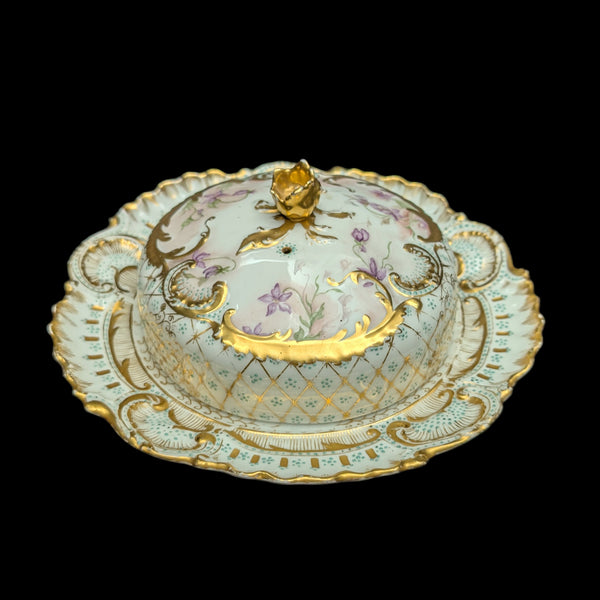
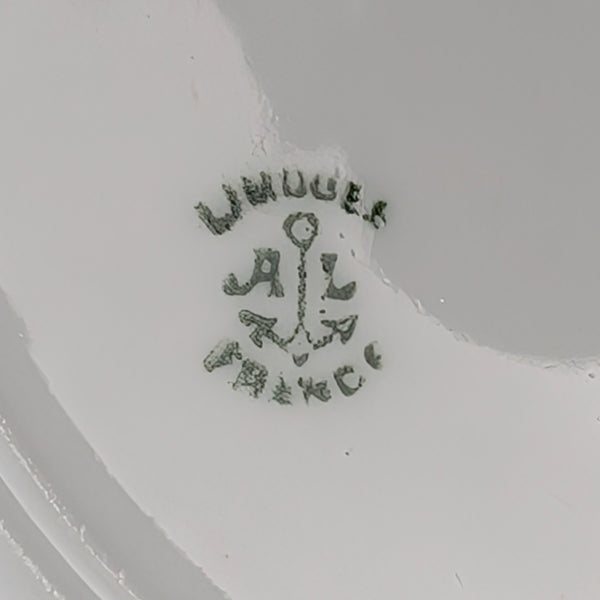
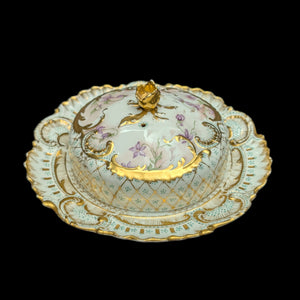
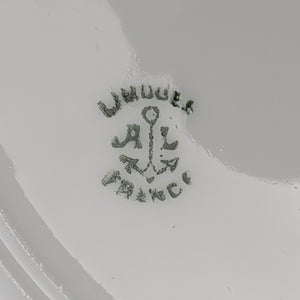
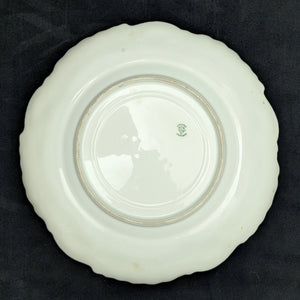

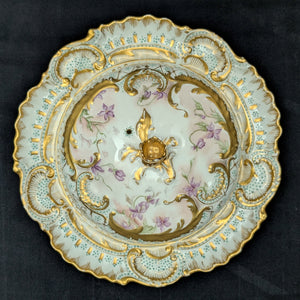
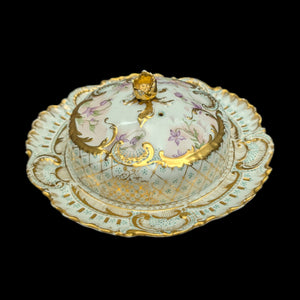
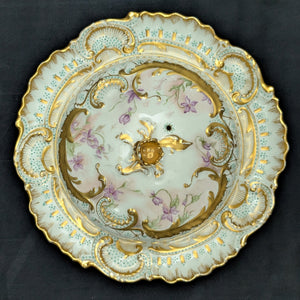
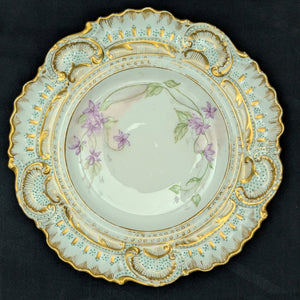
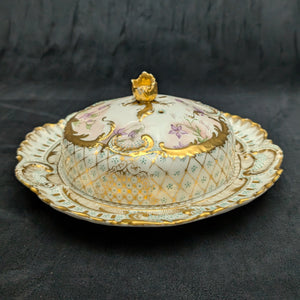




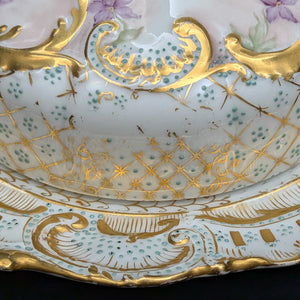
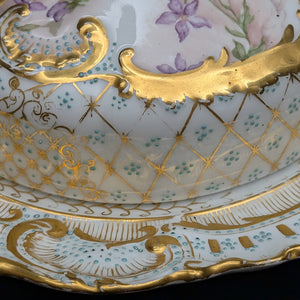
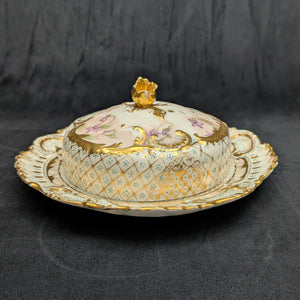
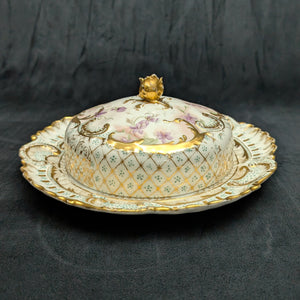
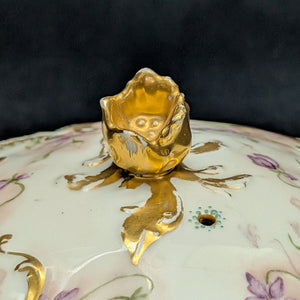
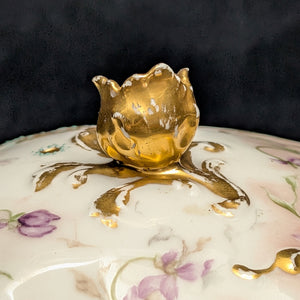
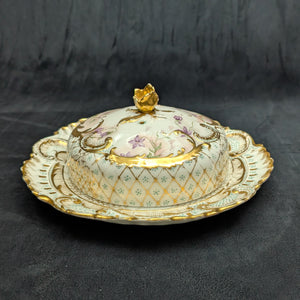
This is a cherished piece of antique porcelain, representing the celebrated artistic legacy of Limoges, France. The piece is a complete covered butter dish, meticulously hand-painted with delicate floral motifs.
The masterful design features intricate gold-gilded accents over a soft, hand-painted wash. The base is clearly marked with the A. Lanternier & Co. mark (the "AL" with anchor), placing its production at the peak of the Limoges golden age. This acquisition is a strong link to the opulent style of late 19th-century French tableware.
2. About the Butter Dish 📖✍️✨
This piece is a functional antique designed for the formal dining table, typically used to serve a stick of butter or a cheese preparation. The set consists of a round serving plate and a domed lid topped with a sculpted gold rose finial.
The decoration is highly ornate: the plate's rim is deeply scalloped and heavily gilded, featuring a beautiful lattice and gold scrollwork pattern. The lid showcases delicate hand-painted purple flowers amidst the scrollwork. Its sophisticated, elegant composition makes it a captivating decorative statement piece.
3. About the Maker: A. Lanternier & Co. ✍️🏛️
The piece is a verified product of Alfred Lanternier & Co., Limoges. The mark on the base, featuring the "AL" monogram with a small anchor (visible in an uploaded file), was used by the factory primarily during the period of 1891 to 1914. Alfred Lanternier joined his father's luxury porcelain workshop in 1890, bringing experience from his time as a Wedgwood representative in England.
Lanternier & Co. was a leader in Limoges production, celebrated for its high artistic quality and adherence to elegant design. The factory received the Grand Prix at the 1925 International Exhibition of Modern Decorative and Industrial Arts. This dish represents the early production of the company under Alfred's influence, cementing its status as a fine French antique.
4. Historical/Political Era Context 🌍🕰️📜
This butter dish was produced during the Belle Époque (Beautiful Era) in France, corresponding to the late 19th and early 20th centuries. This was a time of great artistic and economic prosperity where elaborate, high-quality porcelain tableware was a status symbol in elite European and American households.
The design, with its heavy gilding and Rococo-inspired scalloped forms, reflects the opulent decorative styles favored by this era. Limoges porcelain became a global export staple, and pieces like this are artifacts of France's dominance in luxury decorative arts. The meticulous hand-painting on the lid (visible in the photo) is characteristic of the detailed workmanship expected of pieces from this period.
5. The Ideal Collector 💡🧐🏛️
This Limoges covered butter dish will appeal to a sophisticated collector with an eye for historical French porcelain. The ideal buyer is a Limoges collector, an antique tableware enthusiast, or a curator of late Victorian/Belle Époque decorative arts.
The dish’s complete, two-piece form and documented A. Lanternier mark make it a desirable item for those collecting the specific history of the Limoges region. Its elegance ensures it is a valued centerpiece for a formal dining setting.
6. Value & Rarity 💎✨🏛️
This covered butter dish is valuable for its verifiable A. Lanternier & Co. maker's mark and its high level of detailed artistry. The piece is authentically antique, approximately 110 to 135 years old.
Its market value is sustained by its complete, two-piece form (lid and plate) and the intact, intricate gold gilding over the lattice and scrollwork. The scarcity of fully intact, ornate covered butter dishes from this era, especially with minimal damage to the gilding, secures its premium market value.
7. Condition 🔎📚✨
This antique Limoges porcelain butter dish is in excellent, well-preserved antique condition.
-
Structural Integrity: The lid and plate are free of chips, cracks, or repairs.
-
Artistry: The hand-painted purple and green florals are vibrant.
-
Gilding: The heavy gold trim and lattice work are largely intact, showing only minor, age-appropriate wear.
-
Finial: The sculpted gold rose finial on the lid is present and detailed.
-
Marking: The A. Lanternier & Co. mark is clearly visible on the base.
8. Fun Facts & Unique Features 🤓📜🤩
-
The Anchor Mark: The "AL" anchor mark is an homage to a similar mark used by the famous Wedgewood company in England, where Alfred Lanternier gained experience.
-
Butter Dish Trend: Covered butter dishes, particularly domed styles, were highly popular in the late 19th century to keep butter fresh and cool before modern refrigeration.
-
Scallop Design: The dish's scalloped rim and body draw inspiration from Rococo-era shell motifs, a style heavily revived during the Belle Époque.
-
Gilding Technique: The intense gold work on the lattice and scrollwork of the plate and lid is known as "jeweling" or raised paste gilding, a complex technique that shows the piece's luxury status.
9. Supporting Information 🏷️📦💰
-
Item Name: Covered Butter Dish (Domed Lid)
-
Maker/Factory: A. Lanternier & Co.
-
Period: Antique (c. 1891–1914)
-
Medium/Material: Hand-Painted Porcelain with Extensive Gold Gilt
-
Decoration: Purple Floral Motifs, Gold Lattice, Scalloped Shell Rim
-
Origin: Limoges, France
-
Approximate Dimensions: H: 5.5" (Estimated with lid), W: 9.0" (Plate Diameter)
-
Marking Transcription (Verbatim from Base): Blue Underglaze Stamp: Stylized circular mark with A. LANTENIER & CO LIMOGES FRANCE (Visible in light) / A L with Anchor (Monogram and Symbol).

